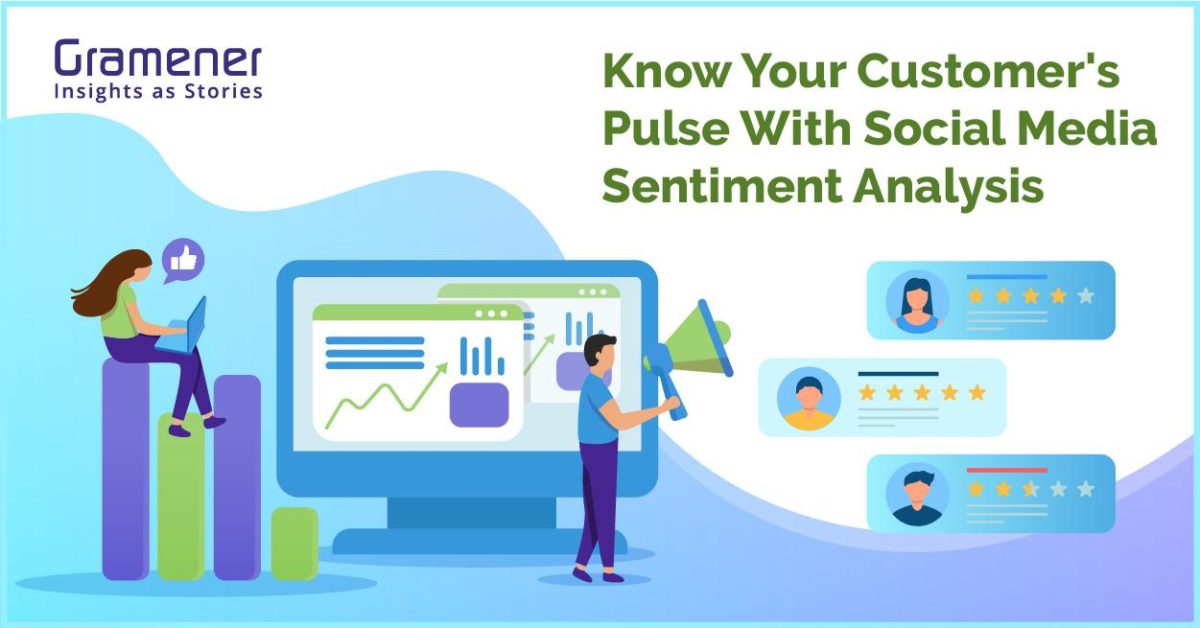User sentiments are potent indicators of how well a product is perceived in the market. It gives the business managers valuable insights like how to market their brands and how users compare the product with the competitors’. Social media sentiment analysis can play a vital role to understand the presence and popularity of a product in the competitive market.
Table of Contents
Scope of Social Media Sentiment Analysis
As Internet penetration in India is at an all-time high, you get many channels from which you can collect these sentiments. A lot of sentiment data is available in the public domain, especially for mobile applications. These platforms include social media and Application Distribution Services such as Play Store and App Store.
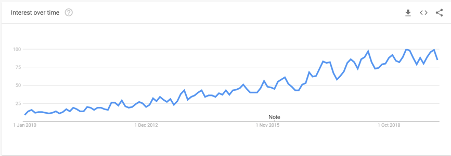
Leveraging Social Media Listening for Customer Sentiments
Currently, brands invest significant sums of money and time in handling and managing social media accounts. Social media teams tend to focus on increasing consumer engagement and tracking their product’s sentiments and competitors. The customer sentiment analysis model can be used to evaluate audience satisfaction levels. Once the data has been acquired you can customize their responses and match the needs of the clients.
Every social media platform has its own API from which you can scrape data and play with it later. Then, the same data is used in techniques such as churn analysis, NLP, sentiment analysis, and behavior analysis to reduce the customer churn.
For example, “Tweepy” is a Python library for accessing the Twitter API. You can use this library to scrape tweets data and also search for tweets containing specific keywords.
However, if you are new to programming and want to scratch the surface of the data goldmine (Twitter), refer to the following few social media listening websites.
SproutSocial
SproutSocial is a useful social media listening tool that lets you connect with any of your social media profiles. Then, it uses your login authorization to search for sentiments of specified keywords. Your keyword input is then used to find the corresponding volume and sentiments of social media posts containing that particular keyword.
To improve your analysis, you will need to weed out repetitive or irrelevant phrases regularly. You have the option to do this using inbuilt Boolean operators.
Let’s say I want to search for sentiments around Google Pay, formerly called as “Tez” in India. Some people might use the short-form “GPay”, as the people posting on social media usually write informal sentences. Merely specifying the keyword “Google Pay” might lead to excluding these edge-cases. Therefore, in this short example, the correct way to input the keywords would be:
“google pay” OR “tez” OR “Gpay
TweetDeck
TweetDeck is a handy tool to scrape Tweets containing keywords, in any particular country, at any given time. This website allows you to track the volume of tweets, engagement rates, likes, and reactions. Since most users tend to communicate with official brands via Twitter, this forms a pivotal platform to listen to sentiments.
This tool’s value addition will be the highest if it is used by the official Twitter account of the brand whose sentiments need to be analyzed. For instance, the best results would be obtained if the Google Pay official Twitter handle uses TweetDeck. That way you get detailed insights on how engagement is growing and what actions are leading to those engagements.
Play Store and App Store
You can analyze the popularity of mobile apps by seeing the number of downloads and ratings. Also, the review section details can be insightful. Users’ keywords to describe the App experience can be a good estimator for several feedback parameters. TweetDeck is a useful tool to analyze the same.
AppBot
AppBot tool helps you scrape reviews from AppStore and PlayStore and create customizable dashboards, depending on your selections.
For example, If I choose “Google Pay – Android”, and key in the concerning timeline and language, I can select a list of features according to my needs. I can choose the “Word Cloud” feature to obtain a word cloud of all reviews given to “Google Pay – Android” from “01/01/2018 – 31/12/2018”. It also gives you a sentiment score out of 100, and the volume of the reviews.
On the basis of these sources, you can generate insights for any app.
The Scope of Social Media Sentiment Analysis with LLMS
The advent of large language models like ChatGPT has significantly transformed the scope of social media sentiment analysis. Here’s how:
Handling Large Volumes of Data
Large language models like ChatGPT can process enormous volumes of social media data in real-time. They can analyze vast numbers of tweets, comments, and reviews swiftly and accurately. This scalability allows businesses to keep pace with the rapid influx of data on social media platforms.
Understanding Context and Nuance
Social media conversations often involve slang, idiomatic expressions, and contextual nuances that can be challenging to interpret. Large language models are trained on diverse datasets, enabling them to understand the subtleties of language and context. They can distinguish between sarcasm, irony, and genuine sentiment, providing more accurate analysis.
Multilingual Capabilities
Social media is a global phenomenon, with conversations happening in numerous languages. Large language models are multilingual, allowing businesses to perform sentiment analysis on a global scale. This capability is essential for multinational companies and brands with a diverse audience.
Emotion Detection
Emojis, emoticons, and GIFs are prevalent in social media communication, expressing a wide range of emotions. Large language models can decode these symbols and understand the emotions they represent, adding depth to sentiment analysis. They can differentiate between positive, negative, and neutral emotions, providing a more nuanced understanding of user sentiment.
Improved Accuracy and Insights
Large language models excel at capturing the intricacies of human language. Their sophisticated algorithms and extensive training data result in higher accuracy when analyzing social media sentiment. Businesses can rely on these models to gain deep insights into customer opinions, preferences, and emotions, leading to more informed decision-making.
Real-time Interaction and Engagement
Large language models like ChatGPT can be integrated into social media platforms, enabling businesses to engage with customers in real time. They can respond to customer queries, feedback, and comments promptly, enhancing customer experience and building brand loyalty.
In summary, the integration of large language models like ChatGPT in social media sentiment analysis expands the scope by enabling businesses to analyze vast and diverse datasets, understand context and nuances, handle multilingual conversations, detect emotions accurately, and engage with customers in real-time. These capabilities empower businesses to derive actionable insights from social media data, ultimately enhancing customer satisfaction and driving business success.
Explore our recent article about ChatGPT for Sentiment Analysis to discover how Large Language Models (LLMs) are enhancing the customer experience.
Social Media Sentiment Analysis – A Case Study
As a Data Consultant intern, I worked on a project to dig out consumer sentiment insights of mobile payment apps and compare them. Here are some of the insights we found from the project.
Cross-platform Popularity
A good indicator of general popularity is the volume of sentiments shared on the Play Store and App Store.
The pie charts show the review of traffic to popular apps.
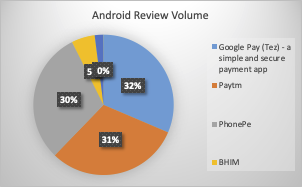
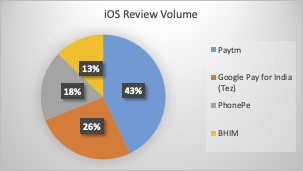
The following chart shows the platform-wise breakdown of total reviews received by each app. The way to read this chart would be: 40% of reviews received by Competitor 2 were for their Android app and the remaining for their iOS app.
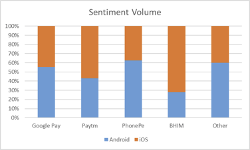
People’s Reaction on Social Media
Tweets and consequent engagement reflects with a fine degree how many people are talking about the app. For example, the following chart explains which app is leading in terms of customer engagement. The spikes can estimate reactions to marketing actions or changes in product features during different time periods.
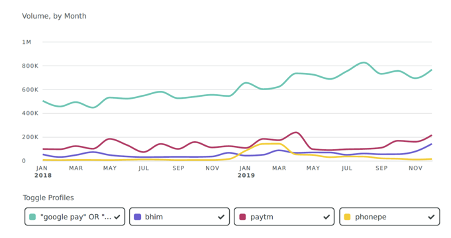
Google Pay’s pattern seems to be a class apart from the other three. The other three apps saw major spikes during the first quarter of 2019. We noticed a similar trend in the last months of 2019 – pointing to a seasonal spike during the Diwali-Christmas festive season.
Affect of Promotional Offers on Sentiments
Android and iOS apps are usually developed by different teams. They cater to different audiences and have various server capacities. As a result, users on these platforms react differently to the same offers and promotions.
The two charts below show the contrast between responses to the same offer by the same app but on different platforms. The red represents negative, and the green represents positive sentiments. The offer was announced during late October, which is indicated by the spike.
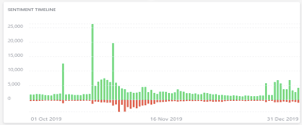
Before the spike in ratings, the Android app used to receive around 2,000 reviews per day, of which 82% of them were positive.
The spike lasted for about three weeks. During this period, the average number of reviews shot up 3.5 times, with 90% being positive.
After the spike, the reviews increased by around 1.5 times, with an 85% positive response.
Overall, the number of purely positive reviews became 310k and constituted 73% of all reviews.
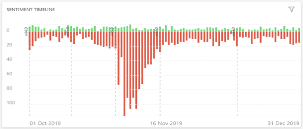
The iOS app saw an entirely different response to the offer. The average number of reviews were around 15 per day, with about 75% of them being negative.
The spike saw numbers reach over 80 each day for two weeks. The sentiments were overwhelmingly negative (85%).
Overall, the iOS app received about 2,500 reviews, 74% of them being purely negative.
Word Cloud to Understand Social Media Sentiments
Word clouds are very convenient to portray the mood, especially with tweets reviewing and responding to the official company Twitter accounts.
We get a clearer picture of what keywords the users use for feedback. These words help us understand the app’s exact feature that the users enjoyed, and those they criticized the most.
Additional benefits are the impact of offers, and promotions can be judged based on the presence of offer-related keywords in the word cloud.
Here are word clouds for Google Pay – Android and iOS.
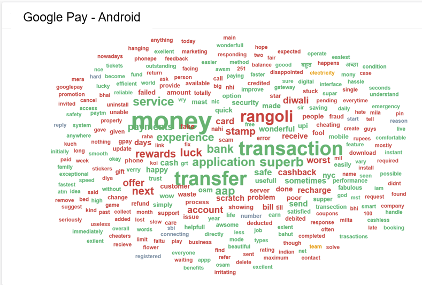
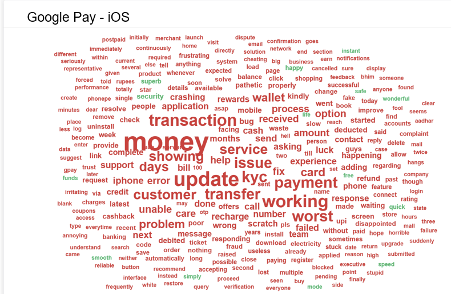
Cross-platform Ratings
The sentiment score of different apps showed the difference between the Android and iOS apps of each competitor. A general trend that was seen was that Android is more likely to perform better than its iOS counterpart.
However, the interesting part is that the BHIM app was an exception. The iOS app got a better response than the Android one.
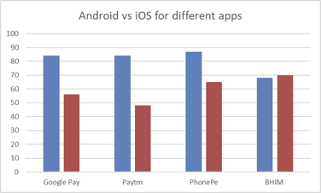
Competitor Analysis Based on Sentiments and Popularity
The plot below is an excellent way to capture sentiments and popularity. Let’s say you have to find out where your app stands currently in the market. This plot will help you get that insight.
A glance at the below chart shows that the competitors lead in the Android market by a wide margin, whereas the competition is tight in the iOS market, with the client having a slight edge.
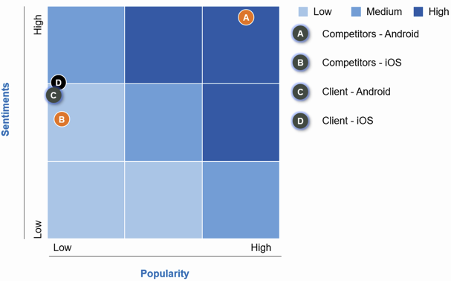
Bottomline
In an age where there is no dearth of real-time data, it should become natural to analyze and use it to one’s advantage.
Insights generated from these analyses can help in making strategic decisions to gain a competitive advantage.
The fact that social media sentiment analysis unearths the emotion behind the reviews, and not only on the volume of reviews, makes it much more scalable and hence useful to small and large businesses alike.
Note: This article is written by Devanand Shenoy, Gramener’s ex-intern.
Gramener has been helping companies to extract the social media sentiments of their customers. You can check out how we improve the Net Promoter Score of our clients with Gramener’s customized NPS Analytics solutions. We work for many Fortune 500 companies to build custom CX solutions. Team Gramener will help you in defining the CX needs based on your company’s CX maturity and handhold you through the process. For more information, contact Amit Garg at amit.garg@gramener.com.

